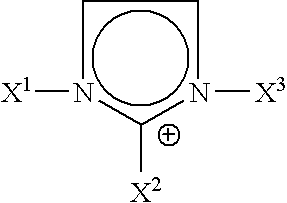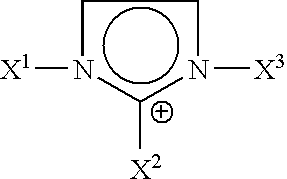Hydrogenation method for unsaturated block copolymers and hydrogenated unsaturated block copolymers
a hydrogenation method and unsaturated block technology, applied in the field of block copolymers, can solve the problems of light-sensitive, crosslinking of polymers, and inability to envisage industrial implementation
- Summary
- Abstract
- Description
- Claims
- Application Information
AI Technical Summary
Problems solved by technology
Method used
Image
Examples
example 1
[0041]A solution of 1.759 g of SBM-1 triblock copolymer in 33.25 g of ethylbenzene and a solution of 15 mg of Wilkinson's catalyst RhCl[P(C6H5)3]3 and of 151.3 mg of triphenylphosphine (TPP) in 15.2 g of 1-butyl-3-methylimidazolium hexafluorophosphate (ionic liquid bmimPF6) are prepared in a glove box under a nitrogen atmosphere.
[0042]These two solutions are subsequently mixed with air excluded and then the two-phase mixture is introduced into a stainless steel autoclave provided with a PTFE internal lining and stirred by a Rushton turbine (stainless steel auto-suction turbine).
[0043]After confirming the leaktightness with nitrogen at 50 bar, the reactor is pressurized with 50 bar of hydrogen and the temperature is brought to 60° C. for 24 hours with stirring (1 000 rev / min).
[0044]After cooling the reactor, 45 mg of Irganox® B900 (stabilizing agent) are added and the reaction mixture obtained (stable emulsion of low fluidity) is then heated to 40° C. and then run into 350 ml of meth...
example 2
[0048]The filtrates from Example 1 (377 g) are concentrated on a rotary evaporator at 90° C. under reduced pressure to remove the methanol.
[0049]1.750 g of SBM-1 triblock copolymer are dissolved in the concentrated solution, positioned with air excluded, and then ethylbenzene is added to bring the volume of the solution to 50 ml.
[0050]This solution is then charged to the autoclave and the hydrogenation is carried out under the same conditions as in Example 1.
[0051]1.70 g of hydrogenated SBM are thus obtained with a degree of hydrogenation of 66% and a rhodium content of 18 ppm.
example 4
[0055]The hydrogenation is carried out as in Example 1, except that the stabilizing agent (45 mg of Irganox® B900) is added before the reaction to the SBM solution (1.754 g of SBM-1 and 33.45 g of ethylbenzene) and except that the hydrogenation reaction is carried out at 120° C. for 24 hours under 50 bar of hydrogen.
[0056]At the end of the reaction, an emulsion is obtained which forms a gel, to which 100 ml of ethylbenzene are added, and heating is carried out at 40° C. to liquefy the gel. The emulsion is subsequently run into 350 ml of methanol at 40° C. with stirring and then the white precipitate obtained is filtered off and dried as in Example 1.
[0057]1.75 g of SBM are obtained, which SBM is 97% hydrogenated and comprises 26 ppm of rhodium, corresponding to 0.42 mg of Wilkinson's catalyst.
PUM
| Property | Measurement | Unit |
|---|---|---|
| Temperature | aaaaa | aaaaa |
| Temperature | aaaaa | aaaaa |
| Temperature | aaaaa | aaaaa |
Abstract
Description
Claims
Application Information
 Login to View More
Login to View More - R&D
- Intellectual Property
- Life Sciences
- Materials
- Tech Scout
- Unparalleled Data Quality
- Higher Quality Content
- 60% Fewer Hallucinations
Browse by: Latest US Patents, China's latest patents, Technical Efficacy Thesaurus, Application Domain, Technology Topic, Popular Technical Reports.
© 2025 PatSnap. All rights reserved.Legal|Privacy policy|Modern Slavery Act Transparency Statement|Sitemap|About US| Contact US: help@patsnap.com


